Water polo is a sport that has been around since the late 19th century and has grown in popularity around the world.
It is a physically demanding sport that requires players to be strong swimmers and has excellent ball-handling skills.
One of the essential aspects of water polo is the water polo ball itself, which is specifically designed for the sport.
Understanding the ins and outs of the game and the equipment used is essential for anyone looking to get involved in water polo.
In this blog post, we will cover everything you need to know about water polo and the water polo ball, including its rules, the history of water polo, the different types of balls used, and tips for choosing the right ball for your game.
Whether you’re a beginner or an experienced player, this guide will provide you with valuable information about water polo and its equipment.
What is water polo?
Water polo is a thrilling and physically demanding sport that is played in water by two teams of seven players each, including a goalkeeper, and the game is played in four quarters, each lasting eight minutes.
The players use their hands to pass and shoot the ball, and they must tread water throughout the game.
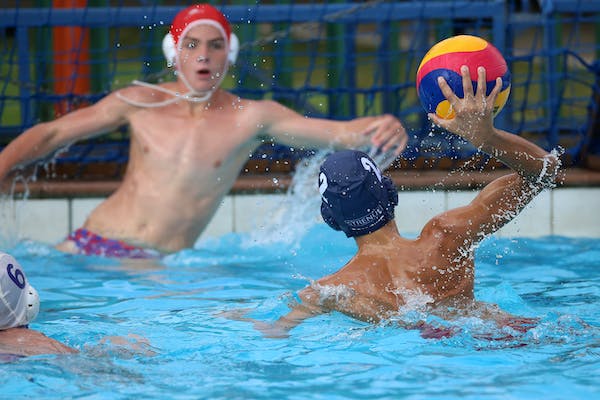
The objective of the game is to score as many goals as possible by throwing a ball into the opponent’s goal while following certain rules and regulations.
The game is played in a pool that is typically 30 meters long and 20 meters wide, with a depth of at least two meters.
The game is very physically demanding and requires a high level of fitness. Players must be able to swim fast, shoot accurately, and defend effectively.
Water polo is also a highly tactical game, with players constantly adjusting their positions and movements to create openings for shots on goal.
Water polo has a rich history, and it is played and enjoyed worldwide.
History of Water Polo
Water polo traces its roots back to the late 19th century when it was first played in England as a form of aquatic rugby.
The game was originally played in lakes and rivers, but it quickly moved to indoor pools.
The first official rules of the game were developed in the 1880s by the London Water Polo League, which standardized the size of the pool, the ball, and the number of players.
From there, the sport spread to other parts of Europe, and it was eventually introduced to the United States in the early 20th century.
The rules of the game have evolved. Originally, the game was played with a softball, but this was replaced with a harder ball in the 1920s.
The size of the pool has also increased over time, and the game is now played in a standard pool that is 25-30 meters long and 20 meters wide.
Popularity of Water Polo Worldwide
Today, water polo is played in over 100 countries, and it is particularly popular in Europe, Australia, and the United States.
In Europe, water polo is a major sport, with professional leagues and national teams competing at the highest levels.
Countries such as Hungary, Serbia, Croatia, Italy, and Spain are among the top water polo nations in the world, with passionate fans and a rich history of success in international competitions.
In Australia, water polo is a popular sport at the grassroots level, with thousands of young players participating in local leagues and tournaments.
The Australian national team is also one of the top teams in the world, with multiple Olympic medals and world championships to their name.
In the United States, water polo has been growing in popularity in recent years, with more and more young athletes taking up the sport.
High school and college teams are prevalent across the country, and there is a professional league, the National Water Polo League, which features some of the top players from around the world.
How deep is the water in water polo?
One of the questions that often arise when people watch or learn about water polo is, how deep is the water in water polo?
The depth of the water in water polo can vary depending on the level of play and the type of pool.

However, the standard depth for a water polo pool is usually around 2 meters (6 feet 7 inches) deep. This depth is consistent across all levels of play, including amateur, collegiate, and professional.
The depth of the water in water polo has a significant impact on the game. For starters, it requires players to be excellent swimmers, as they need to be able to move quickly through the water while handling the ball.
Additionally, the depth of the water affects how players can move and shoot the ball.
Because the water is relatively shallow, players cannot dive or swim underwater for an extended period.
Instead, they must rely on their ability to tread water and stay afloat while passing, shooting, and defending.
This can be a challenging task, especially during extended periods of play or when players become fatigued.
The shallow water also makes it easier for defenders to block shots and prevent goals.
Since players cannot shoot from underwater, they must elevate their shots to clear the defender’s hands and reach the goal.
This can be challenging, as it requires a high degree of accuracy and power to shoot the ball into the top corner of the goal.
Another factor that affects the depth of the water in water polo is the pool’s size. The size of the pool can vary depending on the level of play, with amateur pools being smaller than professional ones.
In general, smaller pools tend to have shallower water depths, as they are easier to fill and maintain.
However, this can also make the game more challenging, as players have less room to move and less time to react.
Can you swim underwater in water polo?
The answer is NO. One of the most important rules in water polo is not swimming with the ball underwater.
This rule is designed to ensure fair play, player safety, and proper ball handling in the game.
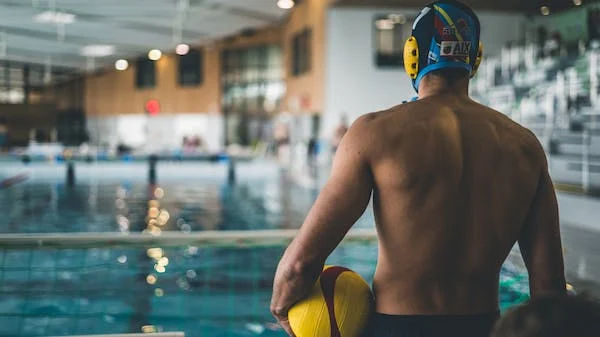
The rule of not swimming with the ball underwater is straightforward: once a player receives the ball, they must pass, shoot, or dribble it immediately.
They cannot hold onto the ball and swim underwater, as this gives them an unfair advantage over their opponents.
This rule is essential in water polo because it ensures that players are playing fairly and using their skills to move and pass the ball.
One of the main reasons for this rule is player safety. If a player is holding onto the ball underwater, they are vulnerable to physical contact from other players.
If a defender crashes into the player holding the ball, it could result in serious injury.
Moreover, the player holding the ball could easily become disoriented or run out of breath while underwater, which could lead to drowning or other dangerous situations.
Another reason for this rule is to promote good ball-handling skills. In water polo, the ball is in constant motion, and players must pass and shoot with speed and accuracy.
By not allowing players to hold onto the ball underwater, the game forces players to make quick decisions and use their skills to move the ball effectively.
This not only makes the game more exciting but also helps players develop their ball-handling skills.
Additionally, not swimming with the ball underwater ensures fair play. If a player could hold onto the ball underwater, they could easily swim past defenders, giving them an unfair advantage.
By not allowing this, the game remains fair and balanced, with all players using their skills to move the ball and score.
Water Polo Ball Rules
As with any sport, there are official rules that govern the game of water polo. Below are the rules of each aspect of the sport.
Gameplay
Water polo is played in a rectangular pool with a goal at each end. The game consists of four quarters, each lasting seven minutes (in international competitions, it’s eight minutes).
In between the second and third quarters, there is a two-minute break, and between the third and fourth quarters, there is a five-minute break.
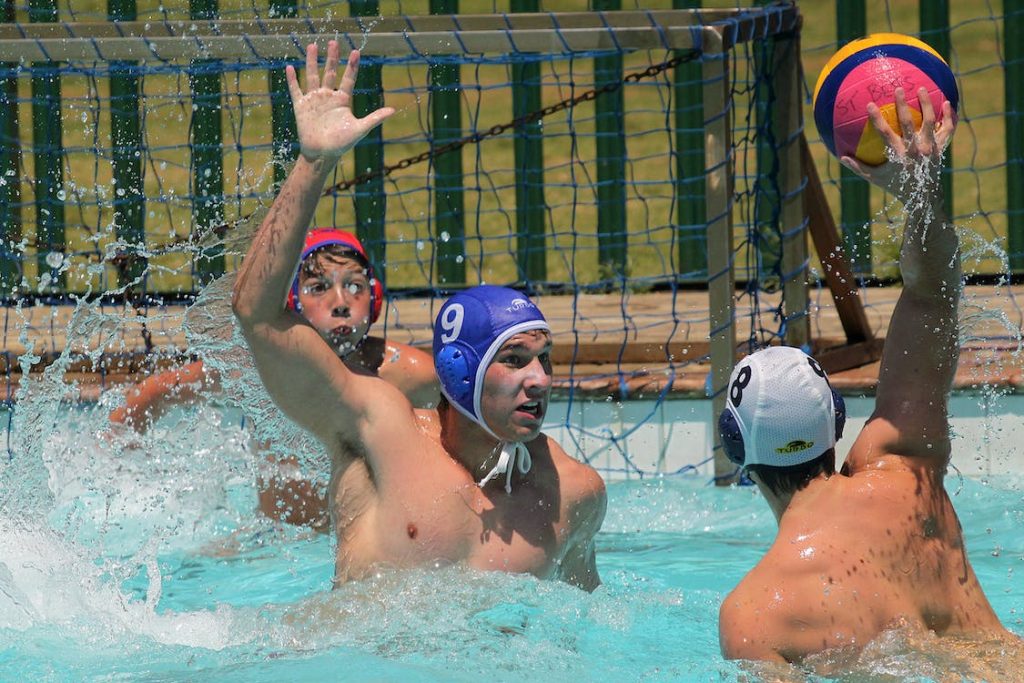
The game begins with a swim-off, where one player from each team starts in the middle of the pool and tries to swim to the ball. The team that gains possession of the ball first is awarded the first possession.
Each team is meant to have seven players in the pool at any given time, including the goalkeeper.
The goalkeeper is the only player who is allowed to touch the ball with both hands. All other players can only touch the ball with one hand, and the ball must not be held underwater.
Handling the Ball
Players in water polo are only allowed to handle the ball with one hand at a time. When a player is holding the ball, they must keep it above the waterline, and they are not allowed to push, hold, or pull their opponents while holding the ball.
Passing the Ball
Passing the ball is an essential part of water polo. Players can pass the ball to their teammates using a variety of techniques, including overhand passing, sidearm passing, and backhand passing.
Players are not allowed to pass the ball with two hands or throw the ball out of bounds intentionally.
Shooting the Ball
The ultimate objective of water polo is to score goals, and shooting the ball is how players achieve this.
A player can shoot the ball at the goal using a variety of techniques, including the wrist shot, the lob shot, and the backhand shot.
A player must shoot the ball within 30 seconds of gaining possession, and they cannot touch the bottom of the pool or the sides of the pool while shooting.
Defending the Ball
Defending the ball is a critical aspect of water polo. Players are allowed to defend the ball using their body, but they are not allowed to impede their opponents by holding or pushing them.
When defending the ball, players must keep their arms and hands out of the way and only use their body to block the shot.
Fouls
Water polo is a contact sport, but there are rules in place to prevent excessive contact or dangerous plays.
A foul is committed when a player does something illegal or unsportsmanlike.
There are several types of fouls in water polo, including:
-
Ordinary fouls: These are minor fouls that do not result in a player being ejected from the game. Examples of ordinary fouls include holding, pushing, or obstructing an opponent.
-
Major fouls: These are more serious fouls that can result in a player being ejected from the game for some minutes. Examples of major fouls include striking, kicking, or elbowing an opponent.
-
Misconduct fouls: These are the most serious fouls, and they can result in a player being ejected from the game for the rest of the match.
Examples of misconduct fouls include intentionally injuring an opponent or using offensive language.
Penalty
When a player commits a foul, they may receive a warning, a yellow card, or a red card.
A yellow card indicates a personal foul, while a red card indicates a misconduct foul.
Misconduct fouls can result in a player being suspended from the game, and their team may have to play with one fewer player.
In conclusion, Water polo is an exciting and challenging sport that requires a great deal of skill and strategy. To play the game successfully, it is essential to understand the official rules of water polo.
By following the rules, players can ensure a fair and enjoyable game for everyone involved.
Whether you are a seasoned pro or just starting, understanding the official rules of water polo is essential to play the game at the highest level.
What kind of ball is used in water polo?
The ball used in water polo is called a water polo ball, it is a unique and specific type of ball designed to withstand the harsh environment of the water and the physical contact between players.
The ball used in water polo is round and made of a rubber material with a textured surface.
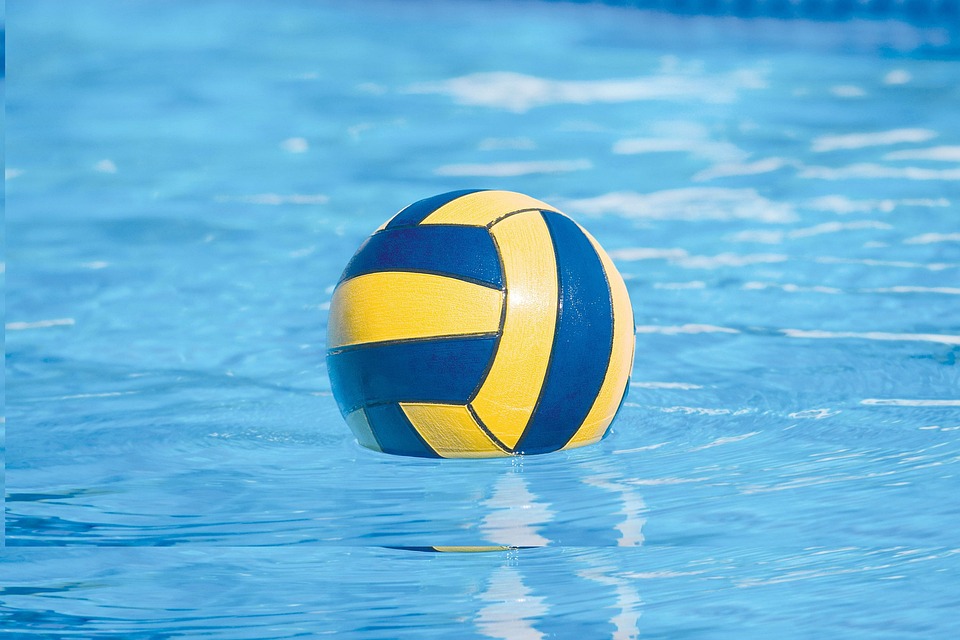
It is typically between 68-71 cm in circumference and weighs between 400-450 grams.
The ball is designed to be easily gripped and passed while also being able to withstand the high-speed impacts of the game.
The water polo ball size and weight are regulated by the international governing body of water polo, the Federation Internationale de Natation (FINA), to ensure fairness and consistency in the game.
The texture on the surface of the ball allows players to grip it better, even when it is wet.
This is especially important because the game is played in a pool, where the ball can become slippery and difficult to handle.
The ball texture also helps to prevent it from being knocked out of the player’s hands easily.
Water polo balls are typically colored in bright shades, such as blue, yellow, or red, to make them more visible in the water.
The bright colors also make it easier for players to spot the ball when it is being passed around or shot towards the goal.
READ ALSO: 10 important things you need to know about western zone swimming
What is water polo ball made of?
As earlier said, water polo balls are typically made of rubber or similar materials that are soft and pliable yet durable enough to withstand the high-impact collisions that occur during gameplay.
The outer layer of the ball is made of a textured material, often dimpled or ribbed, to help players maintain a grip on the ball while it’s wet.
Water polo balls are also designed to be waterproof and resistant to damage from chlorine, as they will be exposed to these elements during gameplay.
Additionally, the ball must be able to float on the surface of the water to allow for easy retrieval by players and referees.
Is a water polo ball fully inflated?
The water polo ball must be fully inflated to the appropriate pressure level to ensure fair play and a level playing field.
A fully inflated ball allows for optimal grip and control, and it can move quickly through the water, making it easier for players to pass and shoot accurately.
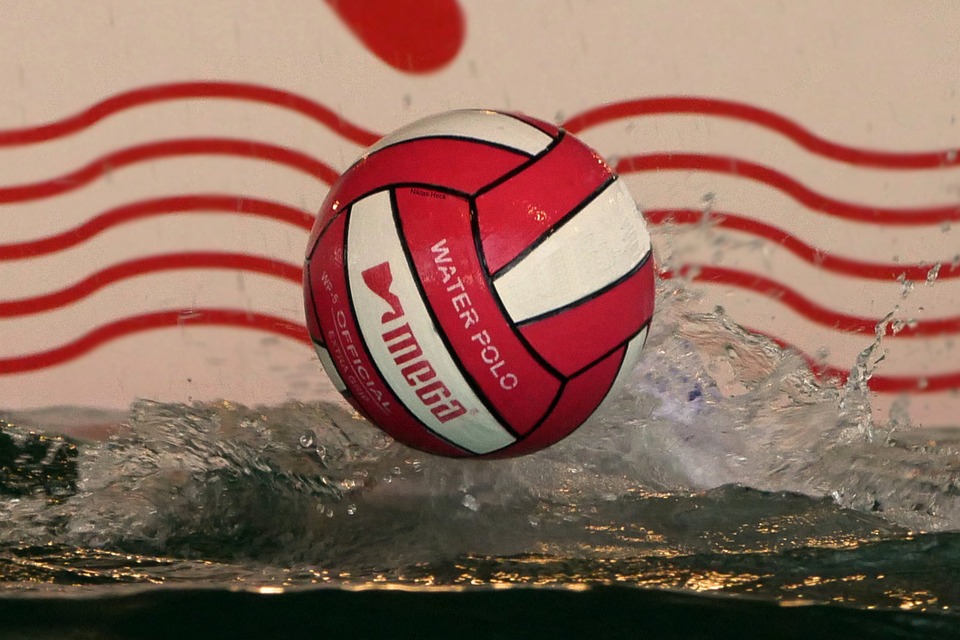
A water polo ball that is under-inflated or over-inflated can negatively affect a player’s performance and can result in unfair advantages.
An under-inflated ball can be challenging to grip, and it may not move as quickly through the water, making it more difficult to pass and shoot accurately.
On the other hand, an over-inflated ball may be too hard and slippery, making it challenging to control and increasing the risk of injury.
To ensure a fair and competitive game, professional water polo players should ensure that the ball is fully inflated to the appropriate pressure level.
Federation Internationale de Natation(FINA), the governing body for water polo, has set a standard for the water polo ball’s inflation level.
According to the FINA regulations, the water polo ball’s pressure should be between 90 kPa (kilopascal) and 97 kPa.
In conclusion, a fully inflated water polo ball is essential for water polo players to achieve optimal performance and fair play.
Proper inflation ensures better grip, control, and accuracy, allowing players to pass and shoot accurately while reducing the risk of injury.
Therefore, water polo players must ensure that their ball is fully inflated to the appropriate pressure level before every game.
How to Properly Inflate Your Water Polo Ball
To get the most out of your water polo ball, it’s important to know how to properly inflate it.
Here are some tips to help you get it right:
-
Check the pressure range: The first step to properly inflating your water polo ball is to check the recommended pressure range.
This information should be printed on the ball itself, or on the packaging it came in. Make sure you have a gauge that can measure this range accurately. - Use a pump: A pump is an essential tool for inflating your water polo ball. A hand pump or an electric pump can work, but make sure it’s specifically designed for inflating sports balls.
-
Lubricate the needle: Before inflating your water polo ball, it’s a good idea to lubricate the needle of the pump. This will make it easier to insert the needle into the ball without damaging it.
-
Insert the needle: Once the needle is lubricated, insert it into the valve of the ball. Be sure to hold the ball steady while doing this to prevent it from moving around too much.
-
Inflate the ball: Begin inflating the ball with the pump, being careful not to exceed the recommended pressure range.
Stop pumping when the ball feels firm to the touch, but still has some give when squeezed.
-
Check the pressure: After inflating the ball, check the pressure with a gauge to make sure it’s within the recommended range.
If it’s too high, release some air until it’s within range. If it’s too low, pump more air into the ball until it’s within range.
-
Tighten the valve: After inflating the ball to the correct pressure, tighten the valve to prevent air from escaping. Be sure to not over-tighten the valve as this could cause damage.
- Store the ball properly: Once your water polo ball is properly inflated, store it in a cool, dry place away from direct sunlight. This will help keep the ball in good condition for as long as possible.
Properly inflating your water polo ball is an important step to ensure it performs well and lasts as long as possible.
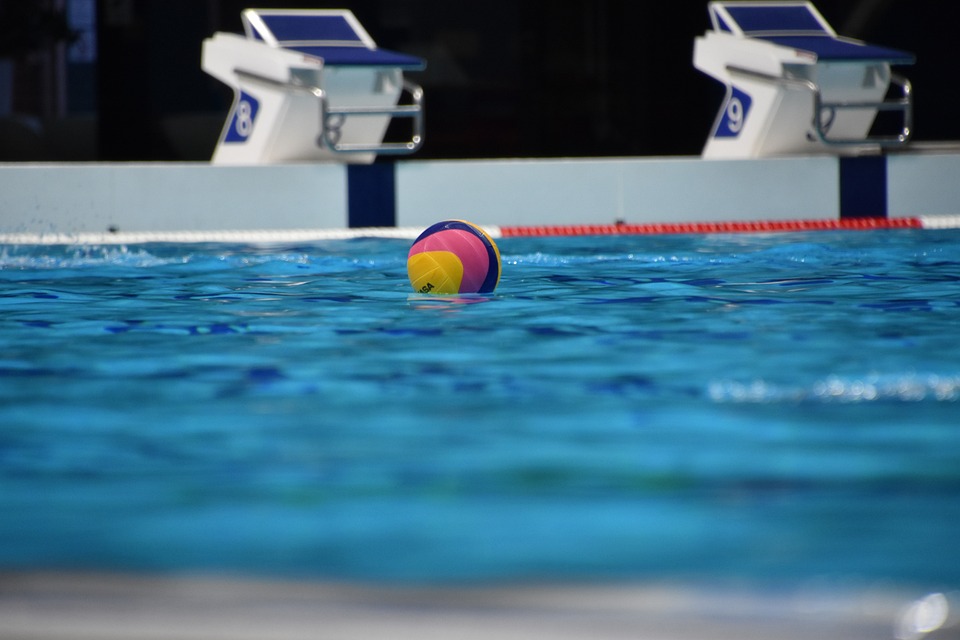
With the above tips, you’ll be able to inflate your ball correctly every time, allowing you to focus on playing the game to the best of your ability.
How to Properly Maintain Your Water Polo Ball
Like any other sports equipment, the water polo ball requires proper care and maintenance to ensure optimal performance and longevity.
Below, we discuss some tips on how to properly care for and maintain your water polo ball, including cleaning, storage, and replacement:
Cleaning
One of the most critical aspects of maintaining your water polo ball is cleaning. Over time, the ball will accumulate dirt, sweat, and other debris that can affect its performance.
Cleaning the ball regularly will help to remove any grime and prevent the buildup of bacteria.
To clean your water polo ball, begin by rinsing it with clean water. Then, use a mild soap and warm water to wash the ball gently.
Avoid using harsh chemicals or abrasive cleaners as these can damage the surface of the ball.
Once you have finished cleaning, rinse the ball thoroughly with clean water and dry it off with a towel.
Storage
Proper storage is also essential for maintaining your water polo ball. Storing your ball correctly will help to prevent it from becoming damaged or misshapen over time.
When not in use, store your water polo ball in a cool, dry place away from direct sunlight.
Avoid storing the ball in areas with high humidity or extreme temperatures as these can cause the ball to degrade more quickly.
Additionally, try to store your ball in a way that will help to maintain its shape, such as by keeping it inflated or using a ball net.
Replacement
Finally, it is important to know when to replace your water polo ball. Over time, the ball will begin to wear down, and its performance will decrease.
Signs that it may be time to replace your ball include visible damage, such as cracks or tears, or if the ball no longer holds its shape or bounces as it should.
If you notice any signs of wear and tear on your water polo ball, it is time to replace it.
While it may be tempting to continue using a worn-out ball to save money, doing so can be more costly in the long run.
A damaged ball can affect your game, leading to lower performance, and may even cause injury.
In summary, proper care and maintenance are essential for ensuring that your water polo ball remains in top condition.
Regular cleaning, proper storage, and timely replacement when necessary will help to prolong the life of your ball and ensure optimal performance on the field.
By following these tips, you can enjoy a great game of water polo with a well-maintained ball.
READ ALSO: 12 things you should know before joining lake oswego swim club
Water Polo Ball Techniques
Water polo sport is a demanding sport that requires a great deal of skill and technique.
Below, we explore the different techniques involved in handling the ball, such as passing, shooting, dribbling, and catching.
Passing the ball
Passing is a fundamental skill in water polo that involves transferring the ball from one player to another.
There are several types of passes, including the standard pass, the lob pass, and the backhand pass.
The standard pass is the most common and is executed by using a throwing motion to propel the ball toward the intended recipient.

The lob pass is used when the receiver is farther away, and the ball is thrown high in the air to give the recipient time to move into position.
The backhand pass is used when the receiver is behind the passer, and the ball is flicked backward using the back of the hand.
Shooting the ball
Shooting is the act of attempting to score a goal by throwing the ball into the opposing team’s net.
There are several techniques involved in shooting, including the traditional shot, the skip shot, and the lob shot.
The traditional shot is executed by throwing the ball with force towards the goal.
The skip shot is used to make the ball skip off the water’s surface, making it more difficult for the goalkeeper to save.
The lob shot is used when the goalkeeper is out of position, and the ball is thrown high into the air, dropping into the goal behind the goalkeeper.
Dribbling
Dribbling is the act of moving the ball past opponents while swimming in the water. It involves using one hand to control the ball while swimming with the other arm.
Dribbling is used to advance the ball up the pool, evade defenders, and create scoring opportunities. It requires a combination of speed, agility, and ball-handling skills.
Catching the ball
Catching is the act of receiving the ball after a pass or a shot. It requires good hand-eye coordination, timing, and positioning.
The two main types of catches are the standard catch and the one-handed catch.
The standard catch is executed by using both hands to trap the ball against the chest.
The one-handed catch is used when the ball is thrown out of reach of the second hand, and the player must reach out and catch it with one hand.
Water polo ball techniques are essential skills for any player looking to succeed in the sport.
Mastering the art of passing, shooting, dribbling, and catching will give players a significant advantage on the field, allowing them to create scoring opportunities, maintain possession of the ball, and contribute to their team’s success.
While these techniques may take time and practice to perfect, they are well worth the effort, as they can make all the difference between victory and defeat.
Benefits of playing Water Polo Ball
-
Improves Cardiovascular Fitness: Water polo is a high-intensity sport that requires constant movement in the water.
Playing this sport can help improve cardiovascular fitness and stamina, leading to a stronger heart and healthier body. - Builds Endurance: Water polo players are constantly moving and treading water, which builds endurance and helps to improve overall fitness levels.
- Strengthens Muscles: Water polo involves a lot of swimming, which works out all major muscle groups, including the arms, legs, back, and core muscles.
-
Enhances Coordination and Balance: Playing water polo requires a high level of coordination and balance.
Players need to be able to move quickly in the water, change direction, and throw the ball accurately, which helps to develop these skills. -
Improves Mental Health: Like all sports, playing water polo can help to reduce stress and improve mental health.
Being part of a team and achieving goals together can also boost self-esteem and confidence.
-
Promotes Social Interaction: Water polo is a team sport, which means players have the opportunity to interact with their teammates and build new friendships.
This social interaction can be especially beneficial for children and teenagers. -
Provides a Full-Body Workout: Water polo is a great way to get a full-body workout, as it combines cardio and strength training in one activity.
Playing water polo can have many positive effects on physical and mental health, and can be a fun way to stay active and engaged with others.
Water Polo Ball Safety Tips

As with any sport, safety should be a top priority. Below are some safety tips for playing water polo ball.
-
Wear Protective Gear: Wearing appropriate protective gear is essential for water polo players, especially when it comes to the head and face.
A water polo ball can travel at high speeds, and a direct hit to the face or head can cause serious injury.
Wearing a properly fitted water polo cap can help protect the head and ears from impact.
Additionally, some players choose to wear a mouth guard for added protection.
-
Hydration: Staying hydrated is crucial when playing water polo, especially in warm or humid weather conditions.
Dehydration can lead to cramps, fatigue, and decreased cognitive function. Make sure to drink plenty of water before, during, and after games or practices.
Sports drinks can also be beneficial for replenishing electrolytes lost through sweat. -
Injury Prevention: There are several steps that players can take to help prevent injuries.
This includes using the correct body positioning when blocking or shooting, as well as using proper kicking and swimming techniques.
Stretching before and after games or practices can also help prevent injuries. Stretching can help increase flexibility, reduce muscle soreness, and improve range of motion.
It is also important to warm up before games or practices by doing light exercises, such as jogging or jumping jacks.
It is important to prioritize safety when playing with a water polo ball. By following these safety tips, water polo players can help reduce their risk of injury and enjoy the game to the fullest.
READ ALSO: History of open water swimming in Australia
Water Polo Ball Equipment and Gears
Like any other sport, water polo requires a specific set of equipment and gears to ensure the safety and fair play of the game.
Below is a list and overview of all the essential equipment and gear used in water polo:
-
Water Polo Ball
The water polo ball is the most critical piece of equipment used in the game. It is made of waterproof material and has a circumference of around 68-71 cm.
The ball must be light enough to float but heavy enough to be thrown with force.
The color of the ball is typically blue and yellow.
-
Water Polo Swim Caps
Water polo swim caps are worn by each player to identify their team and to protect their head and ears from injury.
They are made of soft plastic and cover the player’s head, leaving their ears exposed.
Each team has a different colored cap, and the goalkeeper wears a red cap to distinguish them from the rest of the team.
-
Swim Goggles
Swim Goggles are optional equipment in water polo, but many players prefer to wear them to protect their eyes from chlorine and to improve their vision in the water.
Swim Goggles are also useful for keeping the sun out of a player’s eyes during outdoor games.
-
Water Polo Goalposts
Water polo goal posts are positioned at either end of the pool and are made of metal or plastic.
The goalposts are 3 meters wide and 90 centimeters high, and they have a net attached to catch the ball when a goal is scored.
The goalposts are also marked with white flags to help players judge the distance from the goal.
-
Pool Markers
Pool markers are used to mark the playing area of the pool. They are typically made of plastic and are attached to the sides and bottom of the pool.
Pool markers help players and referees determine if the ball has gone out of bounds.
-
Whistle
The referee uses a whistle to signal the start and end of the game and to indicate when a player has committed a foul.
The whistle is an essential piece of equipment for maintaining the flow and fairness of the game.
-
Swimwear
Players wear swimwear that is designed for water polo, which typically includes a tight-fitting swimsuit for men and a one-piece swimsuit for women.
The swimsuits are made of chlorine-resistant material and are designed to stay in place during the game.
The water polo ball, caps, goggles, goals, pool markers, whistle, and swimwear are some essential pieces of equipment that players need to play the game effectively.
By understanding the importance of each piece of equipment and gear, players can prepare themselves for a successful and enjoyable game of water polo.
Is water polo ball the same as volleyball?
While they may seem similar in some ways, there are notable differences between the equipment used in these sports, particularly the ball.
One common misconception is that the water polo ball and the volleyball are the same.
No, it is not the same ball, water polo and volleyball are two different sports that are often played in different settings.
Water polo balls and volleyballs are different in terms of size, weight, and construction.
Water polo balls are typically made of rubber or similar materials and are designed to withstand the physical demands of the sport.
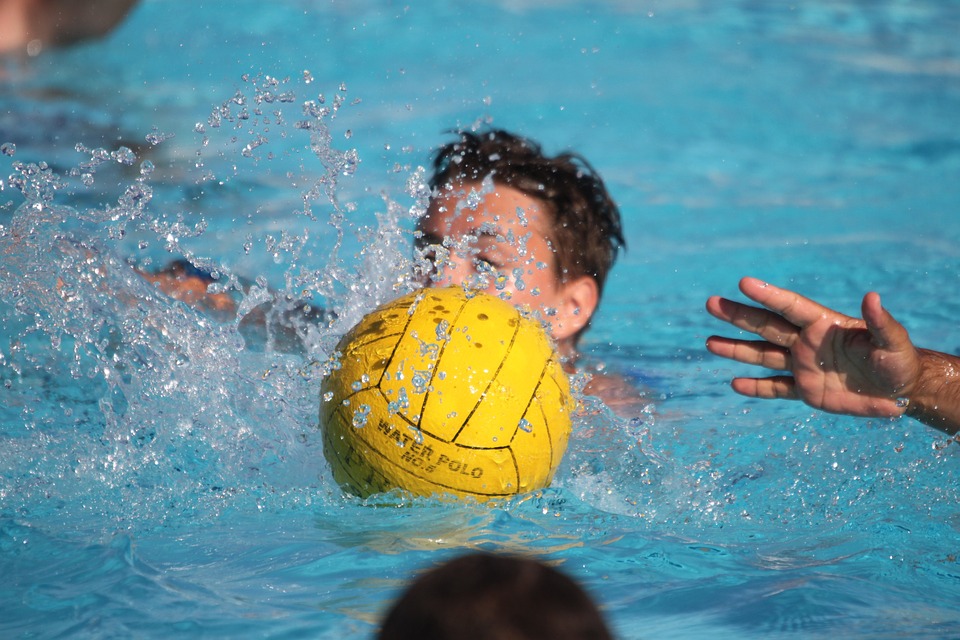
They are typically around 68-71 cm (size 4) in circumference and weigh around 400-450 grams.
Water polo balls are also designed to be more grippy and easier to handle when wet, making it easier for players to control and pass the ball in the water.
On the other hand, volleyballs are typically made of leather or synthetic materials and are inflated to a pressure of 0.3-0.325 kg/cm².
They are around 65-67 cm in circumference and weigh around 260-280 grams.
Volleyballs are designed to be light and bouncy, making it easier for players to serve, spike, and set the ball during a match.
Another difference between the two balls is the way they are used during gameplay.
In water polo, the ball is thrown, passed, and shot into a goal while players tread water or swim around.
In volleyball, the ball is hit over a net by teams of players, who must use their hands or arms to touch the ball up to three times before returning it to the opposing team.
In conclusion, while both water polo and volleyball are popular sports, the balls used in these games are quite different.
The water polo ball is heavier, larger, and designed to be grippy, while the volleyball is lighter and designed to be bouncy.
So, no, the water polo ball is not the same as a volleyball, and players need to use the correct equipment for their sport to play safely and effectively.
How heavy is the water polo ball?
One of the questions that often arise in water polo is how heavy is the water polo ball.
The water polo ball is smaller than a basketball but larger than a softball. It is spherical. The standard size of a water polo ball is size 5.
When it comes to weight, the water polo ball is not particularly heavy.
The weight of the ball can vary depending on the ball level of play, and manufacturer, but the average weight of a water polo ball is around 400-450 grams (14-16 ounces).
This weight is relatively light compared to other balls used in sports such as basketball, which weighs around 600 grams (21 ounces), and soccer ball, which weighs around 410-450 grams (14-16 ounces).
The weight of the water polo ball is carefully regulated by the international governing body for water polo, FINA (Fédération Internationale de Natation).
According to the FINA rules, the ball must weigh between 400-450 grams (14-16 ounces).
Any ball that does not meet this requirement is not suitable for use in official matches.
The weight of the ball is essential to ensure that the game is fair and played with consistent equipment.
READ ALSO: 10 Important Aquatic Skills You Need to Know
Is a water polo ball hard or soft?
The short answer is that water polo balls are generally considered to be hard.
This is because they are made of a dense rubber material that is designed to be durable and able to withstand the rigors of the game.
Another reason why water polo balls are hard is that they need to be able to withstand a lot of physical contact during the game.
Water polo is a very physical sport, with players often jostling and pushing each other to gain possession of the ball.
The ball needs to be able to hold up to this kind of contact without getting damaged or losing its shape.
While water polo balls are generally considered to be hard, some variations can affect their feel and texture.
Some balls have a slightly softer texture than others, which can make them easier to grip and handle.
Additionally, some balls are designed to have a rough texture, which can help players maintain a better grip on the ball in the water.
Can you kick a water polo ball?
Many people who are new to water polo may wonder if it’s possible to kick the ball like in football/soccer, or if the rules prohibit such a move.

The short answer is yes, you can kick a water polo ball, but only in certain situations. Kicking the ball is commonly used by players as a defensive move to block an opposing player’s shot.
However, there are some rules that players must follow when using their feet to play the ball.
First and foremost, players are not allowed to touch the bottom of the pool with their feet while in possession of the ball.
Doing so will result in a turnover, and possession of the ball will be awarded to the opposing team.
Players are also not allowed to use their feet to push off from the side of the pool or any other surface in the pool, such as the lane markers or the goalposts.
This is known as a “kickoff,” and it is considered a foul. If a player is caught doing a kickoff, possession of the ball will be awarded to the opposing team.
Finally, players are not allowed to kick or strike an opposing player. This is considered a foul, and the offending player may be ejected from the game or penalized with a free throw.
How to Choose the Best Water Polo Ball
Choosing the best water polo ball is important for your performance and enjoyment of the game.
Below are tips and guidelines on how to select the best water polo ball based on your needs, playing level, budget, and the different brands available.
-
Consider the Level of Play
The first factor to consider when choosing a water polo ball is your level of play.
If you’re a beginner or play recreationally, you might not need an expensive, high-performance ball.
However, if you’re a professional or competitive player, you’ll need a ball that can withstand the rigors of intense gameplay.
-
Consider the Ball Size
The size of the ball is another important factor to consider. There are four sizes available, and the well-known sizes are, size 2, size 3, size 4, and size 5.
The size 5 ball is the official size used in professional competitions and is best suited for adults.
Size 4 is used for women’s competitions and is also suitable for teenagers. Sizes 2 and 3 are used for children under the age of 12.
-
Consider your type of Material
Water polo balls are typically made of rubber or synthetic materials.
Rubber balls are more durable and affordable, but synthetic balls are faster and have better grip.
Synthetic balls also require less maintenance and are less likely to absorb water.
-
Consider the ball Brand
There are several brands of water polo balls on the market, each with its unique features and price point.
Some of the most popular brands include Mikasa, Turbo, Tachikara, and TYR.
Each brand has its loyal following and reputation for quality, so it’s important to do your research before making a purchase.
-
Consider your Budget
Water polo balls can range from $10 to $50, depending on the size, material, and brand.
Determine your budget and choose a ball that fits within your price range. Keep in mind that higher-priced balls may offer better performance and durability.
Based on the above factors, here are some tips for selecting the best water polo ball for your needs:
-
For adult beginners or recreational players, choose a size 5 rubber ball. These are affordable, durable, and suitable for casual gameplay.
-
For competitive players, choose a high-performance synthetic ball from a reputable brand like Mikasa or Turbo.
These balls are designed for speed, accuracy, and durability.
-
If you’re on a tight budget, consider a size 4 rubber ball from a brand like Tachikara or TYR. These balls are more affordable but still offer decent performance.
- Always consider the size of the ball based on your age and gender. Using the wrong size ball can affect your performance and cause injury.
-
Try different brands and materials to see which one you prefer. The best water polo ball is one that feels comfortable and performs well for your playing style.
With these tips and guidelines, you’ll be able to find a ball that suits your needs and helps you excel in the game.
Conclusion
In conclusion, the water polo ball is a crucial component of the sport and is specifically designed to meet the unique requirements of water polo.
Its size, weight, and composition make it challenging to handle, but its design allows players to use specific techniques to control it effectively.
Without the water polo ball, the game would not be the same, and players would not be able to showcase their skills and abilities.
Its importance cannot be overstated. It requires players to use specific techniques to control it effectively, and its design is tailored to meet the sport’s unique requirements.
As such, any aspiring water polo player or fan of the sport should familiarize themselves with the water polo ball and its properties to appreciate fully the beauty and excitement of this thrilling sport.